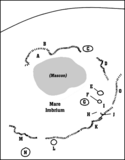Mons Hadley
| ||
 James Irwin i LRV z Apollo 15; Mons Hadley w tle | ||
| Ciało niebieskie | Księżyc | |
| Pasmo | Montes Apenninus | |
| Wysokość | 4600 m nad poziom odniesienia | |
Mons Hadley – masyw w północnej części Montes Apenninus, pasma leżącego na północnej półkuli Księżyca. Góra wznosi się na wysokość 4,6 km, a maksymalna średnica przy podstawie to 25 km.
Na południowy zachód od Mons Hadley znajduje się dolina będąca miejscem lądowania Apollo 15, a jeszcze dalej w tym samym kierunku nieco mniejszy szczyt Mons Hadley Delta (δ) o wysokości około 3,5 km, którego współrzędne wynoszą ☾ 25,8°N 3,8°E/25,800000 3,800000. Na zachód od tych gór leży kręta Rima Hadley.
Nazwy tych miejsc upamiętniają Johna Hadleya.
Rima Hadley
Ta wijąca się dolina ciągnie się na północny wschód w kierunku góry Mons Hadley, od której przejęła nazwę. Jej współrzędne selenograficzne wynoszą ☾ 25,0°N 3,0°E/25,000000 3,000000, a średnica 80 km. Zaczyna się przy kraterze Béla, wydłużonej formacji o wielkiej osi skierowanej na północny zachód.
Pobliskie kratery
Cztery małe kratery w pobliżu doliny zostały nazwane przez MUA. Są one wymienione poniżej.
| Krater | Współrzędne | Średnica | Pochodzenie nazwy |
|---|---|---|---|
| Béla | 24,7° N, 2,3° E | 11 × 2 km | węgierskie imię męskie |
| Carlos | 24,9° N, 2,3° E | 4 km | hiszpańskie imię męskie |
| Jomo | 24,4° N, 2,4° E | 7 km | afrykańskie imię męskie |
| Taizo | 24,7° N, 2,2° E | 6 km | japońskie imię męskie |
Satelickie kratery
Standardowo formacje te na mapach księżycowych oznacza się przez umieszczenie litery po tej stronie centralnego punktu krateru, która jest bliższa Mons Hadley.
| Hadley | Szerokość | Długość | Średnica |
|---|---|---|---|
| C | 25,5° N | 2,8° E | 6 km |
Zobacz też
Bibliografia
- Andersson, L. E.; Whitaker, E. A., (1982). NASA Catalogue of Lunar Nomenclature. NASA RP-1097.
- Blue, Jennifer (25 lipca 2007). of Planetary Nomenclature”. USGS. Dostęp 2007-08-05.
- Bussey, B.; Spudis, P. (2004). The Clementine Atlas of the Moon. New York: Cambridge University Press. ISBN 0-521-81528-2.
- Elijah E. Cocks, Who’s Who on the Moon: A Biographical Dictionary of Lunar Nomenclature, Josiah C. Cocks, wyd. 1st ed, Greensboro: Tudor Publishers, 1995, ISBN 0-936389-27-3, OCLC 32468980.
- McDowell, Jonathan (15 lipca 2007). Nomenclature”. Jonathan’s Space Report. Dostęp 2007-10-24.
- Menzel, D. H.; Minnaert, M.; Levin, B.; Dollfus, A.; Bell, B. (1971). on Lunar Nomenclature by The Working Group of Commission 17 of the IAU”. Space Science Reviews 12: 136.
- Moore, Patrick (2001). On the Moon. Sterling Publishing Co.. ISBN 0-304-35469-4.
- Fred William Price, The Moon Observer’s Handbook, Cambridge [Cambridgeshire]: Cambridge University Press, 1988, ISBN 0-521-33500-0, OCLC 17548914.
- Rükl, Antonín (1990). Atlas of the Moon. Kalmbach Books. ISBN 0-913135-17-8.
- Webb, Rev. T. W. (1962). Celestial Objects for Common Telescopes (6th revision ed.). Dover. ISBN 0-486-20917-2.
- Ewen Adair Whitaker, Mapping and Naming the Moon, Cambridge [England]: Cambridge University Press, 1999, ISBN 0-521-62248-4, OCLC 39633902.
- Wlasuk, Peter T. (2000). Observing the Moon. Springer. ISBN 1-85233-193-3.
Linki zewnętrzne
Media użyte na tej stronie
Black up-pointing triangle ▲, U+25B2 from Unicode-Block Geometric Shapes (25A0–25FF)
Autor:
- Nuvola_apps_kmoon.png: David Vignoni / derivative work: Lady Whistler (talk)
Icon from Nuvola icon theme for KDE 3.x.
Image from Apollo 15, taken by Commander David Scott at the end of EVA-1. Lunar Module Pilot Jim Irwin is seen with the Lunar Roving Vehicle, with Mount Hadley in the background. Seen on the back of the Rover are two SCBs mounted on the gate, along with the rake, both pairs of tongs, the extension handle with scoop probably attached, and the penetrometer. Note that the TV camera is pointed down, in the stowed position.
cylindrical map projection of the Moon. The Moon's whole surface was mapped by the Clementine spacecraft in 1994, here North is at the top. The dark floor of crater Plato is at the middle top above Mare Imbrium, while the bright floor and rays of crater Tycho is near the middle bottom below Mare Imbrium. Mare Procellarum is at the near left, and Mare Tranquillitatis is just right of centre and Mare Crisium is at the near right. The far left and far right show the contrast of the mostly cratered farside with small isolated mare.
(c) Luc Viatour, CC-BY-SA-3.0
Nearly Full Moon view from earth In Belgium (Hamois).








